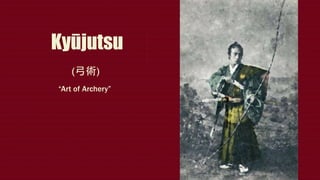
Kyūjutsu 'Art of Archery'
- 2. What is Kyūjutsu Kyūjutsu is a form of Japanese archery, from this principle Kyu means "bow" and Jutsu means "method of“. So essentially Kyujutsu is the technique of fighting with the bow. It has been around for many centuries and was used in many battles amongst the various warring clans of feudal Japan, at one point in history it was the primary weapon of the samurai class. Although the samurai are perhaps best known for their swords, kyūjutsu was actually considered a more vital skill for a significant portion of Japanese history. During the majority of the Kamakura period through the Muromachi period (c.1185– c.1568), the bow was almost exclusively the symbol of the professional warrior.
- 3. The beginning of archery in Japan is, as elsewhere, pre- historical. The first images picturing the distinct Japanese asymmetrical longbow are from the Yayoi period (ca. 500 BC–300 AD). The first written document describing Japanese archery is the Chinese chronicle Weishu (dated around 297 AD), which tells how in the Japanese isles people use “a wooden bow that is short from the bottom and long from the top The changing of society and the military class (samurai) taking power at the end of the first millennium created a requirement for education in archery. This led to the birth of the first kyūjutsu ryūha (style), the Henmi-ryū, founded by Henmi Kiyomitsu in the 12th century. The Takeda- ryū and the mounted archery school Ogasawara-ryū were later founded by his descendants. The need for archers grew dramatically during the Genpei War (1180–1185) and as a result the founder of the Ogasawara- ryū (Ogasawara Nagakiyo), began teaching yabusame (mounted archery).
- 4. From the 15th to the 16th century, Japan was ravaged by civil war. In the latter part of the 15th century Heiki Danjō Masatsugu revolutionized archery with his new and accurate approach called hi, kan, chū (fly, pierce, center), and his footman’s archery spread rapidly. Many new schools were formed, some of which, such as Heki-ryū Chikurin-ha, Heki-ryū Sekka-ha and Heki- ryū Insai-ha, remain today. The Yumi as a weapon of war began its decline after the Portuguese arrived in Japan in 1543 bringing firearms with them in the form of the matchlock. The Japanese soon started to manufacture their own version of the matchlock called tanegashima and eventually the tanegashima and the yari (spear) became the weapons of choice. The yumi, however, would be continued to be used alongside the tanegashima for a period of time because of its longer reach, accuracy, and especially because it had a rate of fire 30–40 times faster. The tanegashima however did not require the same amount of training as a yumi, allowing Oda Nobunaga’s army consisting mainly of farmers armed with tanegashima to annihilate a traditional samurai cavalry in a single battle in 1575. Heki Danjō Masatsugu teaches kyūjutsu to Yoshida Shigekata.
- 5. Yumi In Kyūjutsu the bow, (Yumi), has a long history of use in war, it was also used for hunting, ceremonial events, and court games. The Yumi bow is over two metres in length and asymmetrical in shape with the grip (nigiri) located one third above the bottom portion of the bow. The yumi is constructed today using the same methods as used centuries ago, primarily with bamboo and wood but can and are also made using todays more modern materials too (e.g. Carbonfibre). The string on the bow (tsuru) was traditionally made from natural fibres e.g. hemp or horsehair and arrayed in different ways for multiple uses, but today can also be made using more modern synthetic fibres, like Dacron.
- 6. Ya Ya refers to the arrows used by samurai during the feudal era of Japan. Unlike Western arrows, the ya is close to a metre long or longer. Traditional ya are made from natural materials, usually bamboo, while modern ones may use aluminium or carbon fibre. The arrows are fletched with hane (feathers) about fifteen centimetres in length and can be the most expensive part of the arrow. Traditionally, the outermost tail feathers of large birds of prey were considered the finest. Many of these birds are now endangered – in particular the sea eagle – therefore, feathers of lesser eagles, swans, geese or even turkeys are being used in modern times. On the other hand, owl feathers were never used, as they were thought to be bringers of misfortune. They would use feathers from both the left and right wing, because wing feathers naturally curve left or right. Ya with feathers from the left wing are called haya and they spiral clockwise, whereas ya made from the right wing feathers are called otoya and they spiralled counter- clockwise.
- 7. Ya used for target practice have a conical iron tip called a ne. Ya used in war by the samurai had a variety of tips called yajiri or yanone; these arrowheads were forged using the same steel (tamahagane) and methods as traditional Japanese swords. There are many different kinds of arrowhead and they all have their own special name. Togari-ya is a simple pointed design. The yanagi-ba, also known as "willow-leaf", is known for its elegant design. Karimata have a unique split point, and are sometimes referred to as "rope-cutters". The barbed "flesh-torn" is known as watakushi. The tagone-ya is shaped like a chisel. Kaburi-ya was used for signalling and creating fear with the loud whistling noise it would produce. They were also large enough that they could be signed on the tang by the fletcher in the manner of Japanese swords.
- 8. Tsuru / Tsurumaki The string on the bow (tsuru) was traditionally made from natural fibres e.g. hemp or horsehair and arrayed in different ways for multiple uses, but today can also be made using more modern synthetic fibres, like Dacron. Tsurumaki, is a traditional woven Japanese bowstring holder.
- 9. For more information www.kyujutsuinternational.com kyujutsu.co.uk Follow us: Facebook - Pinterest - Instagram - Twitter
